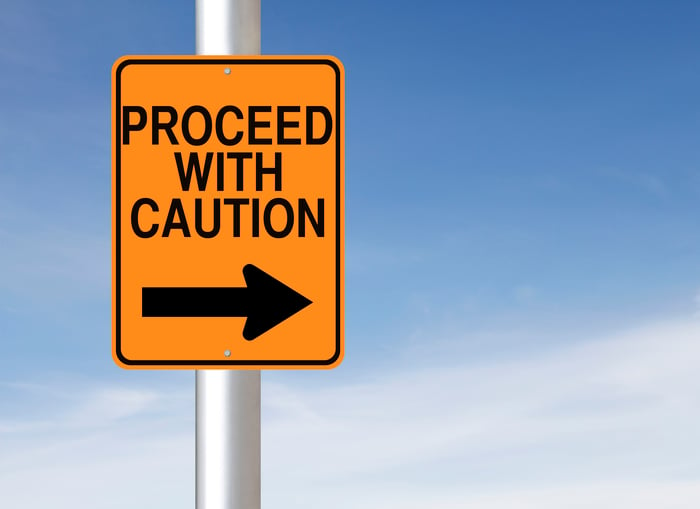"The young man knows the rules, but the old man knows the exceptions."
-- Oliver Wendell Holmes Sr.
In finance as in life, depending too rigidly on rules without considering their shortcomings and exceptions can be dangerous. The famous "4% rule" for the withdrawal of funds from a nest egg during retirement is a perfect example.

Image source: Getty Images.
The 4% rule is very simple and handy, but it won't work for everyone in every situation. Let's take a closer look at some of its key problems.
Meet the 4% rule
The 4% rule, introduced by financial advisor Bill Bengen in 1994 and later made famous in a study by several professors at Trinity University, says that you can withdraw 4% of your nest egg in your first year of retirement, adjusting future withdrawals for inflation. It assumes a portfolio that's 60% in stocks and 40% in bonds, and it's designed to make your money last through 30 years of retirement.
That all sounds pretty good, right? Let's run through an example. Imagine you've saved $400,000 by the time you retire. In your first year of retirement, you withdraw 4%, or $16,000. In year two and every following year, you'll need to adjust that withdrawal rate for inflation. Let's say inflation over the past year was at its long-term historic rate of 3%. If so, you'll multiply your $16,000 withdrawal by 1.03 and you'll get your second year's withdrawal amount: $16,480. The following year, if inflation is still around 3%, you'll multiply that by 1.03 and get a withdrawal amount of $16,974. See? Pretty easy.

Image source: Getty Images.
The advantages of the 4% rule
The upside of the 4% rule is clear: It makes it easy to figure out how much you can safely withdraw from your retirement nest egg each year, while making that nest egg last a long time. After all, one of the biggest retirement fears people have is running out of money.
If you flip it around, the 4% rule can also help you determine how much you'll need to accumulate in the first place. You first have to know how much annual income you'll want in retirement, though. Let's say, for example, that you'd like total income of $60,000, and you expect to collect $25,000 from Social Security. That leaves $35,000 in income you'll need to generate on your own. It would be your first year's withdrawal. So if you assume that $35,000 is 4% of your nest egg, then you can multiply $35,000 by 25 to arrive at how big the nest egg will need to be: $875,000. (Why 25? Because 1 divided by 0.04 is 25.)
Here's a look at the initial-year withdrawals that come with various nest eggs, going by the 4% rule:
|
Nest Egg |
4% First-Year Withdrawal |
|---|---|
|
$300,000 |
$12,000 |
|
$400,000 |
$16,000 |
|
$500,000 |
$20,000 |
|
$600,000 |
$24,000 |
|
$750,000 |
$30,000 |
|
$1 million |
$40,000 |
Data source: author calculations.

Image source: Getty Images.
Serious problems with the 4% rule
Of course, the 4% rule isn't as perfect and simple as that, as Oliver Wendell Holmes Sr., reminded us. Here are three problems with it.
It's based on certain assumptions: Remember that the 4% rule wasn't created to work perfectly in every situation and that it's the product of certain assumptions. For starters, it aims to make your money last for 30 years, but if you retire at 60 and live to 97, your nest egg will need to support you for 37 years. It also uses a portfolio split 60-40, respectively, between stocks and bonds. You might not have or might not want that allocation. If your portfolio is split 50-50, or you have 75% of it in stocks, then the 4% rule will be less applicable to your situation. Indeed, a Vanguard study found that over 35 years, the rule worked only 71% of the time for a portfolio equally divided between stocks and bonds. Consider, too, that the rule isn't guaranteed to make your money last for 30 years. A T. Rowe Price study found that it offered a 90% probability that a portfolio made up of 60% stocks and 40% bonds would last for 30 years. That's pretty good, but a 10% failure rate is still significant.
Market movements can mess with it: Then there's our friend the stock market, which never moves in a straight line. Yes, its overall trend has always been up, but it can point downward for quite a while, and it's not very predictable. Market volatility can really mess with the 4% rule. You might have a nest egg of $500,000 a year before you retire, but what if the market suddenly crashes by 10% or 20%? Or what if it crashes and stays depressed soon after you retire? You might have withdrawn $20,000 in year one, but if you take out $20,600 in year two from a nest egg that has shrunk to $400,000, you'll be withdrawing 5%, not 4%, which might shorten the life of your portfolio. Conversely, if the market soars in your retirement's early years, you might be short-changing yourself by taking out a smaller percentage than you could.
The economic environment can hurt its effectiveness: Finally, there's the economic environment to consider. Remember that the rule was created more than 20 years ago, when interest rates were higher. Mortgage rates in 1994 were in the 8% range, and one-year CDs paid about 4%. In such an environment, the bond portion of a portfolio would have been generating more income than bonds do today. (A two-year government bond recently yielded 1.3%.) We've been in a low-interest-rate environment for a long time now, rendering our bonds less able to replenish funds withdrawn each year. Each span of 20 to 30 years is different.

Image source: Getty Images.
Salvaging the 4% rule
So given all those problems with the 4% rule, what should you do? Well, don't throw it out entirely. It's still handy as a rough guide and you can tweak it to make it serve you better. Here are some strategies to consider:
- Take market conditions into consideration. In a year when the market drops, withdraw less money. In a year when it booms, you might take a little more. Some advisors suggest not adjusting your withdrawal for inflation in any year when the market falls or your portfolio shrinks.
- Another adjustment to the rule that can lengthen the life of your nest egg is to never increase your withdrawals for inflation, on the assumption that you'll spend less each year over time, growing less active as you age. So if your initial withdrawal is $16,000, it will stay at $16,000. You may or may not be able to pull this off, as inflation will be working against you and healthcare expenses often increase in retirement. But maybe you can.
- If you find that you're withdrawing more than you really need to spend, cut back on your withdrawals.
- If you can afford to do so, consider withdrawing less than 4% annually. You might also work a few years longer than you had planned, to shorten your retirement and plump up your nest egg a bit more. (Alternatively, just boost your income in retirement.) The more conservative you are, the smaller the likelihood that you'll run out of money, but you're also more likely to die with a large unspent balance -- and perhaps have fewer years of retirement to enjoy.
- If you're retiring late and expect your retirement to be shorter than most, you might withdraw more than 4% annually -- maybe 4.5% or 5%.
- You might also look into immediate fixed annuities (not the more problematic indexed or variable annuities). They can provide guaranteed income for life and remove a lot of uncertainty and worry.
At a minimum, re-evaluate the state of your nest egg and the size of your withdrawals regularly throughout your retirement – especially in the early years. You want to remain on track to having your money outlast you.
Remember that it can be quite helpful to tap the expertise of a professional, too -- ideally from a fee-only advisor. Sure, it will cost you -- but the guidance may save you much more than it costs.




